Calligraphy is sheer life experienced through energy in motion that is registered as traces on silk or paper, with time and rhythm in shifting space its main ingredients.
As an art educator in China, incorporating Chinese calligraphy elements into my classes became second nature. However, upon returning to the West, I faced the challenge of integrating this captivating art form into my curriculum in a meaningful way.
Fortunately, the open-ended and process-based qualities of Chinese calligraphy seamlessly fit into a Reggio-based curriculum. It quickly emerged as a powerful medium to introduce Western students to Chinese culture while also serving as a valuable tool for practicing mindfulness techniques and art therapy.
Join me on this journey as we explore the millennia-old history of Chinese calligraphy, its prominent features, and its contemporary implementation in Chinese art today. Together, we’ll delve into the rich cultural heritage behind this art form.
Throughout this post, I’ll share resources and activities that make Chinese calligraphy accessible and enjoyable for children of all ages. We’ll unravel the techniques, styles, and philosophies behind this art, providing a pathway for creative exploration.
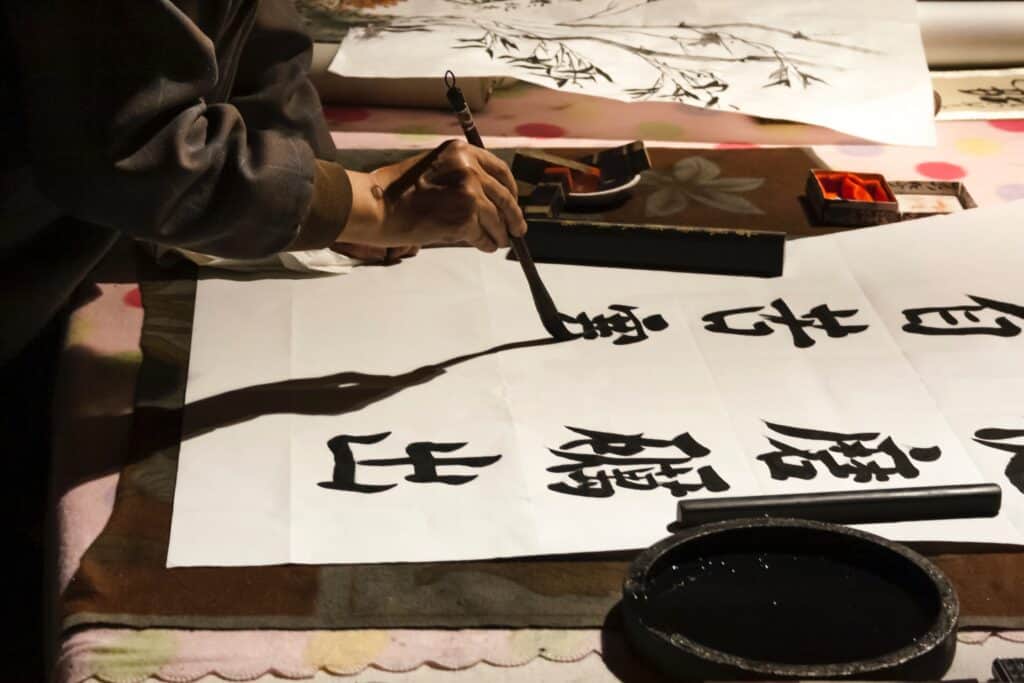
Chinese calligraphy is more than a means of communication—it is a profound art form that embodies the essence of Chinese culture, philosophy, and spirituality. It goes beyond the mere act of writing and becomes a vehicle for self-expression, a form of meditation, and a way to explore the beauty and harmony of the natural world. The process of creating Chinese calligraphy is as important as the final characters on the page, much like the focus of Montessori and Reggio Emilia learning approaches.
In Chinese calligraphy, artists carefully choose their brushes, ink, and paper and embark on a deliberate and mindful journey of creating each stroke. Rather than aiming for perfection, calligraphers embrace imperfections and allow the energy to flow naturally through their brushwork. The emphasis is on authentic self-expression and the exploration of personal artistic expression, rather than on achieving a predetermined outcome.

This aligns with the principles of Montessori and Reggio Emilia, where process-based learning takes precedence over a focus on the end result. Children are encouraged to engage in hands-on exploration, experimentation, and self-directed learning. By immersing themselves in the artistic process of calligraphy, they learn the value of practice, resilience, and personal expression. Just like that, Chinese calligraphy becomes a medium through which they can experience the joy of creating and appreciate the beauty of imperfections and improvisation.
Interest in Chinese culture? Check out our complete guide to Chinese knotting, or our favourite list of children books to read during Mid-Autumn Festival.
You may also be interested in:
- Chinese Knots how-to: The complete guide to Chinese New Year traditional craft
- How to Incorporate Art into Different Subjects Curriculums
- “Letterscape” Calligram Art Activity: Text Art Exploration
- How to Create Calligram Poetry: Surrealism Art Interdisciplinary Lesson Plan
- Mid-Autumn Moon Festival Children Books | Art Sprouts’s Favourite Pick
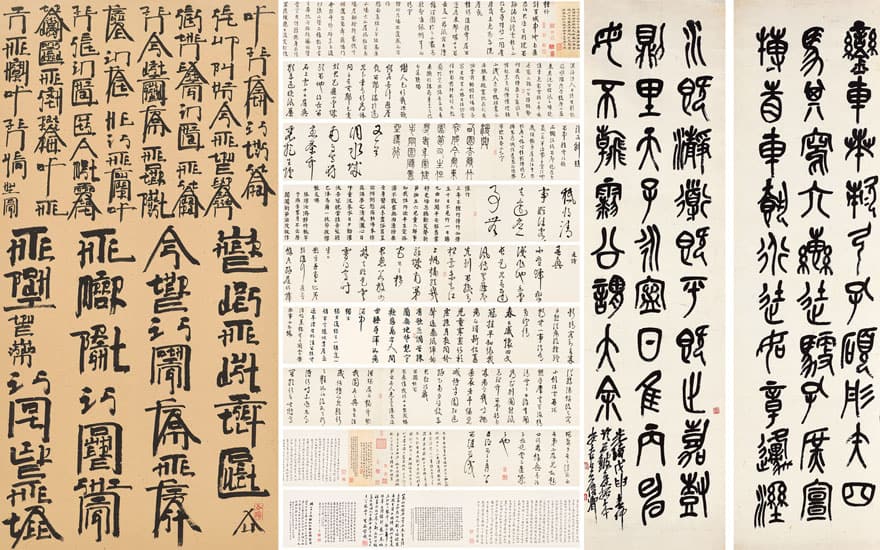
Chinese calligraphy: beauty beyond language
Each brushstroke in Chinese calligraphy carries meaning and conveys a sense of energy, rhythm, and harmony. Calligraphers use their skillful manipulation of the brush, ink, and paper to evoke emotions and express their innermost thoughts and feelings. The expressive power of Chinese calligraphy extends beyond the literal meanings of the characters and encompasses the overall aesthetics and emotional resonance conveyed by the composition and brushwork.
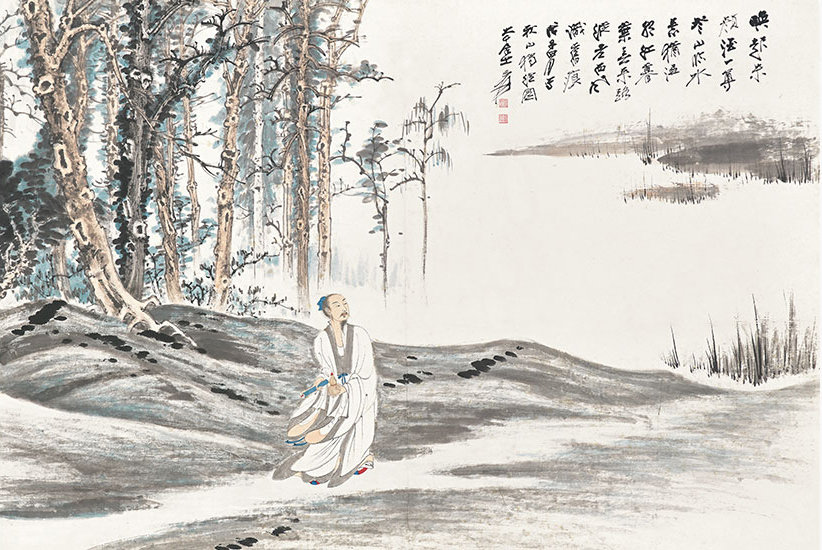
For centuries, calligraphy has been held in high esteem in Chinese culture, alongside other essential arts like playing musical instruments, the Go strategy game, and painting. The literati, who were the educated scholars of ancient China, considered calligraphy as more than just a skill or hobby—it was an integral part of their identity and expression. Mastery of calligraphy was seen as a reflection of one’s wisdom, refinement, and cultivation.
DISCUSSION PROMPT: What do you think Chinese calligraphy is? How is it different from writing in your language?
Use your finger to draw imaginary characters in the air, mimicking the brush movements of calligraphy. Can you feel the flow and rhythm in your hand?
FURTHER RESEARCH: Compare the expressive power of Chinese calligraphy to other forms of visual art, such as painting or sculpture. How does calligraphy evoke emotions and convey meaning?

Interestingly, the concept of “art” as understood in the Western context is a relatively recent introduction in Chinese culture. The term “yìshù” (艺术), which translates to “art” in Chinese, emerged in the late 19th and early 20th centuries as China encountered Western art forms and ideas. Prior to this, the various forms of artistic expression, such as painting, sculpture, music, theater, and literature, were not categorized separately in traditional Chinese culture.
As China underwent modernization and reform, intellectuals and artists began to adopt Western artistic concepts and practices. To encompass the Western notion of “art” as a distinct and specialized field of creative expression, the term “yìshù” was adopted. It became widely used in Chinese society to encompass a diverse range of artistic disciplines and practices, aligning with the global understanding of art as a separate domain.
Further reading:
- The role of poetry in Chinese painting via Christie’s
- RELIGION AND PHILOSOPHY IN CHINESE CALLIGRAPHY – THE IMPACT OF NEO-CONFUCIANISM ON CALLIGRAPHY: CULTURAL IDENTITY AND EMULATION
- RELIGION AND PHILOSOPHY IN CHINESE CALLIGRAPHY – BUDDHISM AND CHINESE CALLIGRAPHY: MAD MONKS
- Chinese calligraphy on Khan’s Academy
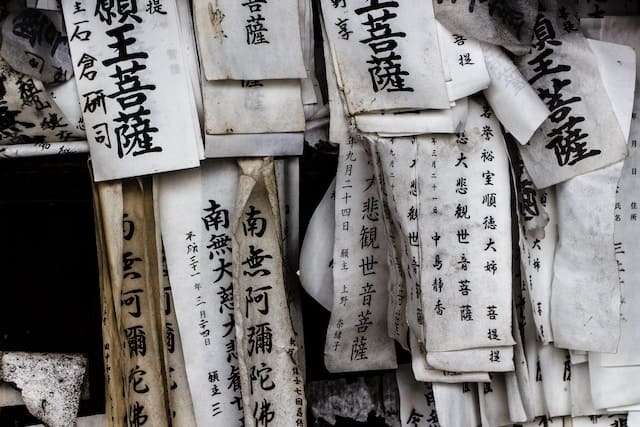
Chinese script styles
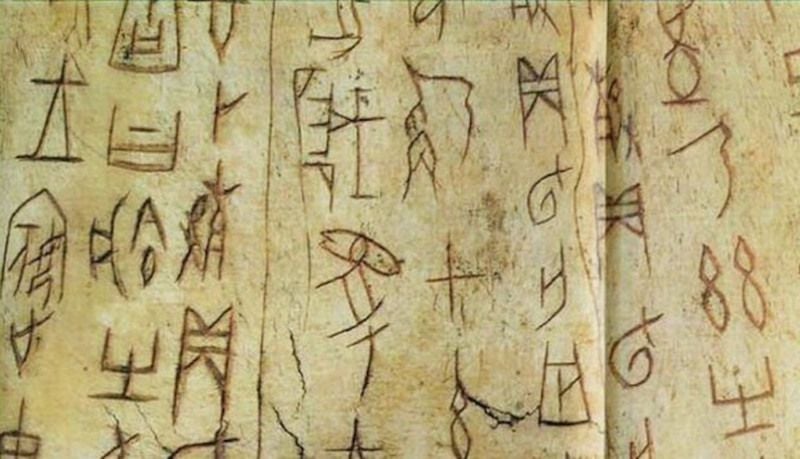
Oracle bone script
Calligraphy has a remarkable history that dates back to the very origins of Chinese writing, making it nearly 5000 years old. What’s fascinating is that the Chinese writing system itself is one of the oldest continuously used writing systems in the world. The earliest known script in Chinese history is the Oracle bone script, which emerged during the Shang Dynasty in ancient China around the 14th century BCE.
During this time, the Oracle bone script served primarily for divination purposes. It involved inscribing characters onto animal bones and turtle shells, which were then heated or cracked to seek answers from the spiritual realm. These bones and shells contained questions posed by rulers or individuals seeking guidance on matters such as crops, weather, and governance.
The characters of the Oracle bone script were still predominantly pictographic in nature, meaning that they were stylized representations of objects or ideas. They were created by carving or writing with a sharp tool onto the surface of the bones or shells. The calligraphers of that era carefully crafted each stroke, producing a script that was both artistic and functional.
Over time, the Chinese writing system evolved, becoming more abstract and ideographic, representing ideas and concepts rather than literal objects. The Oracle bone script played a crucial role in the development of Chinese characters and provided a foundation for the writing system we see today.
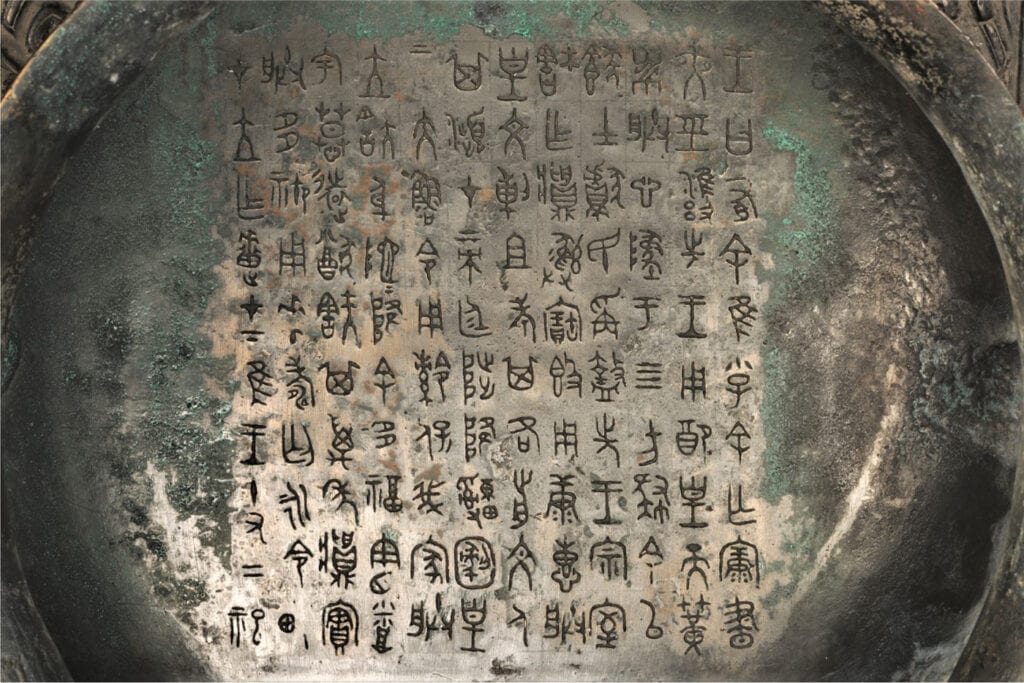
Bronze Inscription 金字 Jinzi
Another significant script in the history of Chinese calligraphy is the Bronze Inscription script, commonly referred to as Jīnzì. This script emerged during the Shang and Zhou dynasties, approximately from the 14th century BCE to the 3rd century BCE. As the name suggests, it was primarily used for inscribing characters onto bronze artifacts, such as ceremonial vessels, weapons, and ritual objects.
The Bronze Inscription script represents a transition in the Chinese writing system from the pictographic nature of the Oracle bone script to a more standardized and stylized form. The characters in this script began to exhibit more abstract and angular shapes, deviating from the pictorial representations of earlier scripts. This shift allowed for greater efficiency in writing and engraving on bronze surfaces.
The Bronze Inscription script holds immense historical and cultural significance. It not only conveyed important information about the objects it adorned but also reflected the social and political systems of the time. The inscriptions often contained genealogical records, historical events, and the names of rulers, providing valuable insights into the governance, rituals, and beliefs of ancient Chinese civilizations.
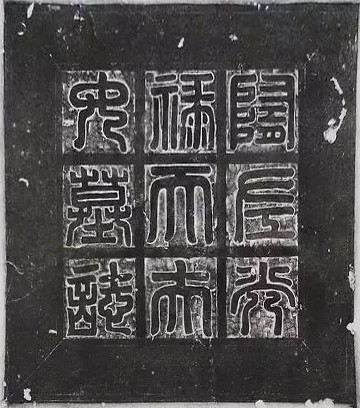
Seal script 篆书 Zhuanshu
One of the most iconic and distinctive scripts in Chinese calligraphy is the Seal Script, known as Zhuànshū. It originated during the Eastern Zhou Dynasty, around the 5th century BCE, and reached its peak of popularity during the Qin Dynasty in the 3rd century BCE. The Seal Script derived its name from the fact that it was primarily used for engraving seals, which were used as personal or official marks of authentication.
The Seal Script is characterized by its bold, angular, and square-shaped characters. It features strong lines and intricate strokes, often resembling pictographic or ideographic symbols. This script reflects a high level of abstraction and refinement compared to earlier scripts, making it both visually striking and challenging to master.
The Seal Script holds great cultural and historical significance in Chinese calligraphy. It became the standard script for official documents and inscriptions on seals during the Qin Dynasty, as it symbolized the authority and power of the emperor. The elegance and compactness of the characters made them well-suited for engraving on small surfaces.
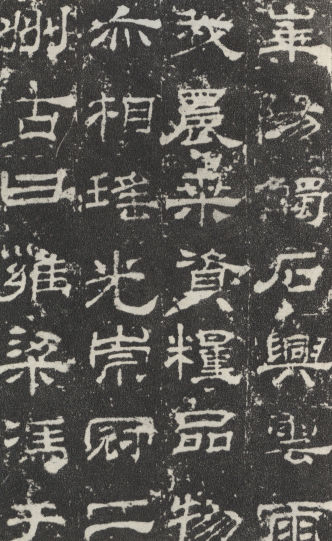
Rubbing from a tablet in Huashan temple (华山庙碑)
Clerical Script 隶书 Lishu
Lìshū, or Clerical script, is another important script in the history of Chinese calligraphy. It emerged during the Han Dynasty (206 BCE – 220 CE) and was widely used for official documents and bureaucratic purposes. Lìshū marked a departure from the earlier scripts in terms of its structure and stroke formation. The characters in this script became more square and angular, with clearly defined strokes and simplified forms.
One of the distinctive features of Lìshū is its emphasis on efficiency and legibility. The script was developed to facilitate faster writing, making it suitable for the demands of administrative tasks. The characters were standardized and simplified, allowing for easier recognition and comprehension. Despite its functional nature, Lìshū still retained an element of artistic expression, as calligraphers employed various techniques to give the characters a sense of rhythm and balance.
Lìshū played a crucial role in the standardization of Chinese characters, paving the way for the development of subsequent scripts. It greatly influenced the formation of other calligraphy styles and became a foundation for later scripts, such as Xíngshū and Kǎishū. Additionally, Lìshū left a lasting impact on the aesthetics of Chinese calligraphy, with its bold and structured strokes continuing to inspire contemporary calligraphers.

Regular script 楷书 Kaishu
Kǎishū is one of the most widely recognized and commonly used scripts in Chinese calligraphy. It emerged during the Wei and Jin Dynasties (220-420 CE) and became the prevailing script for writing during the following periods. Kǎishū is characterized by its clear and balanced structure, with well-defined strokes and a regularity that enhances its legibility.
The development of Kǎishū marked a shift towards a more standardized and formal writing style. It was extensively used for various purposes, including official documents, literature, and artistic inscriptions. The script’s simplicity and clarity made it suitable for widespread communication and dissemination of information.
One of the distinguishing features of Kǎishū is its emphasis on symmetry and uniformity. The characters are carefully composed, with equal spacing between strokes and consistent proportions. Calligraphers strive to achieve a harmonious balance between the vertical and horizontal elements of each character, creating a sense of visual equilibrium.

Semi-cursive 行书 Xingshu
Xíngshū, or Semi-Cursive script, emerged during the Han Dynasty (206 BCE – 220 CE) and reached its peak of popularity during the Tang Dynasty (618 – 907 CE). It is considered a bridge between the more formal and structured Kǎishū (Regular script) and the fluid and expressive Cǎoshū (Cursive script).
Xíngshū is characterized by its semi-cursive nature, combining elements of both the Regular and Cursive scripts. The characters in Xíngshū exhibit a greater degree of fluidity and speed compared to Kǎishū, as the brush moves more quickly and strokes are connected in a flowing manner. However, it still retains some structural integrity, making it more legible than Cǎoshū.
This script is highly valued for its aesthetic appeal and expressive qualities. Calligraphers who practice Xíngshū have the freedom to add personal touches and variations to the characters, infusing them with a sense of vitality and dynamism. The strokes in Xíngshū are more loosely connected compared to Kǎishū but still maintain a level of clarity and readability.
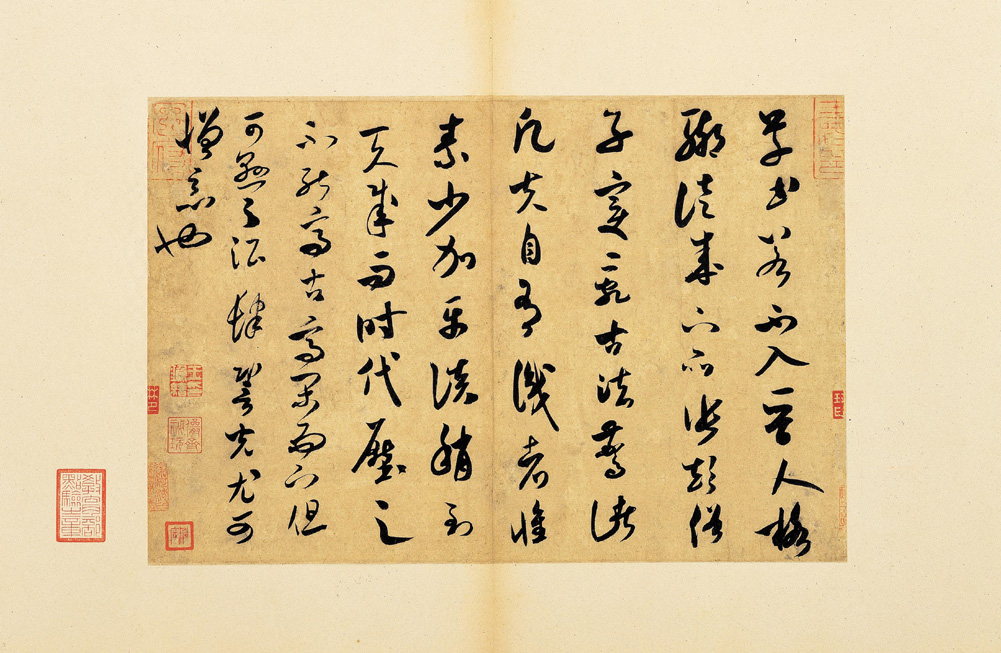
Cursive 草书 Caoshu
Cǎoshū, or Cursive script, is a highly cursive and fluid style of Chinese calligraphy. It originated during the Han Dynasty (206 BCE – 220 CE) and reached its peak of development during the Jin Dynasty (265-420 CE) and the Tang Dynasty (618-907 CE). Cǎoshū is characterized by its rapid, flowing strokes and simplified forms, which often deviate significantly from the standard script.
Unlike more structured scripts, such as Kǎishū and Lìshū, Cǎoshū prioritizes speed and expressiveness over legibility. Calligraphers employ swift, sweeping motions to create continuous and interconnected strokes, resulting in a distinctively cursive appearance. This style allows for greater freedom and creativity, as artists can experiment with variations and flourishes in their brushwork.
Cǎoshū is often regarded as a highly personal and intimate form of calligraphy. It captures the vitality and spontaneity of the calligrapher’s emotions and thoughts in the moment of writing. It is said that Cǎoshū reflects the inner essence and spirit of the calligrapher, as the flowing brushstrokes capture the energy and passion behind the written characters.
Tools and materials
Traditional Chinese calligraphy relies on a set of distinctive tools and materials that have been used for centuries to create exquisite artworks. The most fundamental tool is the brush, carefully crafted with animal hair, such as wolf, rabbit, or goat, secured to a bamboo or wooden handle.
The selection of a brush depends on the desired effect, with variations in thickness, flexibility, and texture. Equally important is the ink, traditionally produced by grinding ink sticks on an inkstone with water. This meticulous process yields a lustrous black ink that flows smoothly and dries to a velvety finish. The inkstone, typically crafted from stone or ceramic, serves as the platform for grinding and blending the ink.

Moreover, calligraphers choose specific types of paper and silk renowned for their unique texture and absorbency, enabling the ink to be applied with precision.
Here is a list of recommended materials:
Please note that these supplies have been chosen keeping their cost in mind. For professional use, much better products are available on the market, starting with traditional ink sticks, but with much more substantial price tags.
Famous Chinese calligraphers from the past
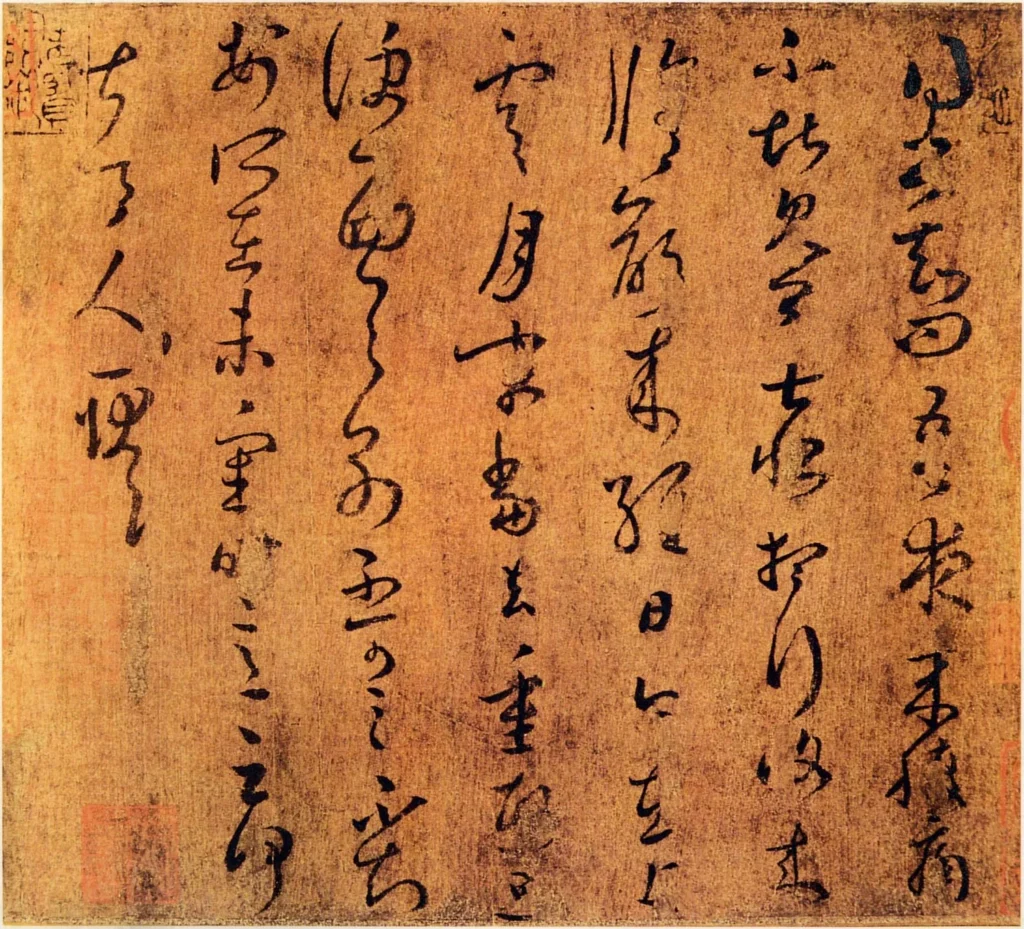
Wang Xizhi (303-361 AD)
Wang Xizhi is widely regarded as the greatest calligrapher in Chinese history. His calligraphy style, known as “Lanting Xu” or “Preface to the Poems Composed at the Orchid Pavilion,” is considered a masterpiece. Wang Xizhi’s calligraphy is known for its elegance, rhythm, and balanced composition. His work had a profound impact on subsequent generations and set the standard for Chinese calligraphy.

Yan Zhenqing (709-785 AD)
Yan Zhenqing was a prominent calligrapher during the Tang Dynasty. His style, known as “Yan Li,” is characterized by strong and bold strokes with a sense of power and vitality. Yan Zhenqing’s calligraphy is highly regarded for its expressive nature and skillful use of brushwork. He is revered for his mastery of the art form and his ability to infuse emotion into his writing.

Su Shi (Su Dongpo, 1037-1101 AD)
Su Shi was not only a renowned poet, writer, and statesman but also a skilled calligrapher. His calligraphy style, known as “Su Shi Tie,” is admired for its graceful and free-flowing strokes. Su Shi’s calligraphy reflects his playful and imaginative personality, and his work showcases a sense of spontaneity and creativity. He is revered for his versatility and his contributions to both literature and calligraphy.

Liu Gongquan (778-865 CE)
Liu Gongquan, also from the Tang Dynasty, is recognized for his mastery of the regular script style. His calligraphy is known for its meticulous brushwork, precise structure, and balanced composition. Liu Gongquan’s influential work, “Preface to the Poems Collected from the Orchid Pavilion,” is regarded as a model of the regular script and has had a lasting impact on subsequent calligraphers.
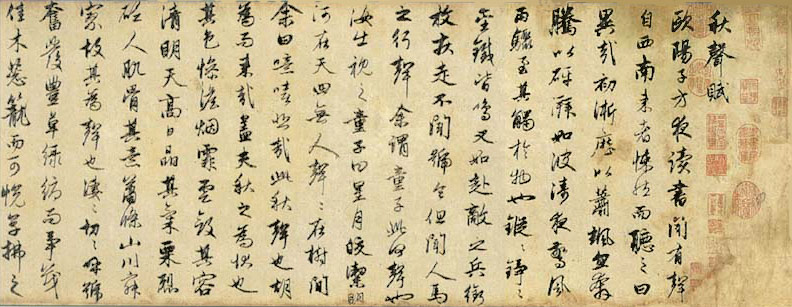
Zhao Mengfu (1254-1322 CE)
Zhao Mengfu was a notable calligrapher and painter of the Yuan Dynasty. He excelled in various calligraphy styles, including the regular script, running script, and cursive script. Zhao Mengfu’s calligraphy is highly regarded for its versatility, balance, and skillful use of brush techniques. He is known for integrating the spirit of ancient calligraphers into his own work while adding his personal creativity and innovation.
Chinese calligraphy in contemporary art
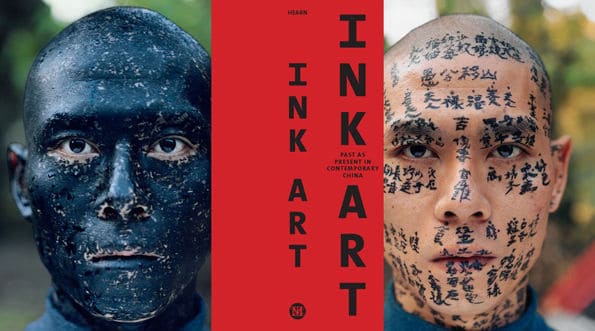
This blog post was inspired by one of my favourite art catalogue of all times, the “Ink Art: Past as Present in Contemporary China” exhibition held at the Metropolitan Museum from December 11, 2013, to April 6, 2014. The exhibition featured works by 35 of the most relevant Chinese artists who explored the use of ink as a medium and its connection to Chinese cultural heritage, reinterpreting and reimagining traditional ink art forms, and blending them with contemporary artistic expressions and ideas.
Here are some of the most notable ones:
Xu Bing
Xu Bing is a renowned contemporary Chinese artist known for his innovative and thought-provoking artworks that challenge traditional perceptions of language and communication. His art often explores the relationship between written language, calligraphy, and cultural identity.

One of Xu Bing’s most notable works related to Chinese calligraphy is “Square Word Calligraphy.” In this series, he created a unique writing system that combines elements of Chinese characters with Latin alphabet letters, resulting in a visually striking and inventive script. By merging the two writing systems, Xu Bing questions the notion of language as a cultural signifier and challenges the viewer’s preconceived notions of what is familiar and foreign.
Another significant work by Xu Bing is “Book from the Sky.” In this installation, he created thousands of handmade books filled with meticulously printed characters that resemble traditional Chinese writing. However, upon closer inspection, the characters are entirely invented and have no actual meaning. This work confronts the viewer with the ambiguity and unreliability of written language, questioning the authority and authenticity of communication.
Xu Bing’s art not only pushes the boundaries of traditional calligraphy but also explores the power dynamics and cultural complexities associated with language. His works challenge conventional interpretations of written texts and invite viewers to contemplate the nature of communication, cultural identity, and the role of calligraphy in contemporary society.
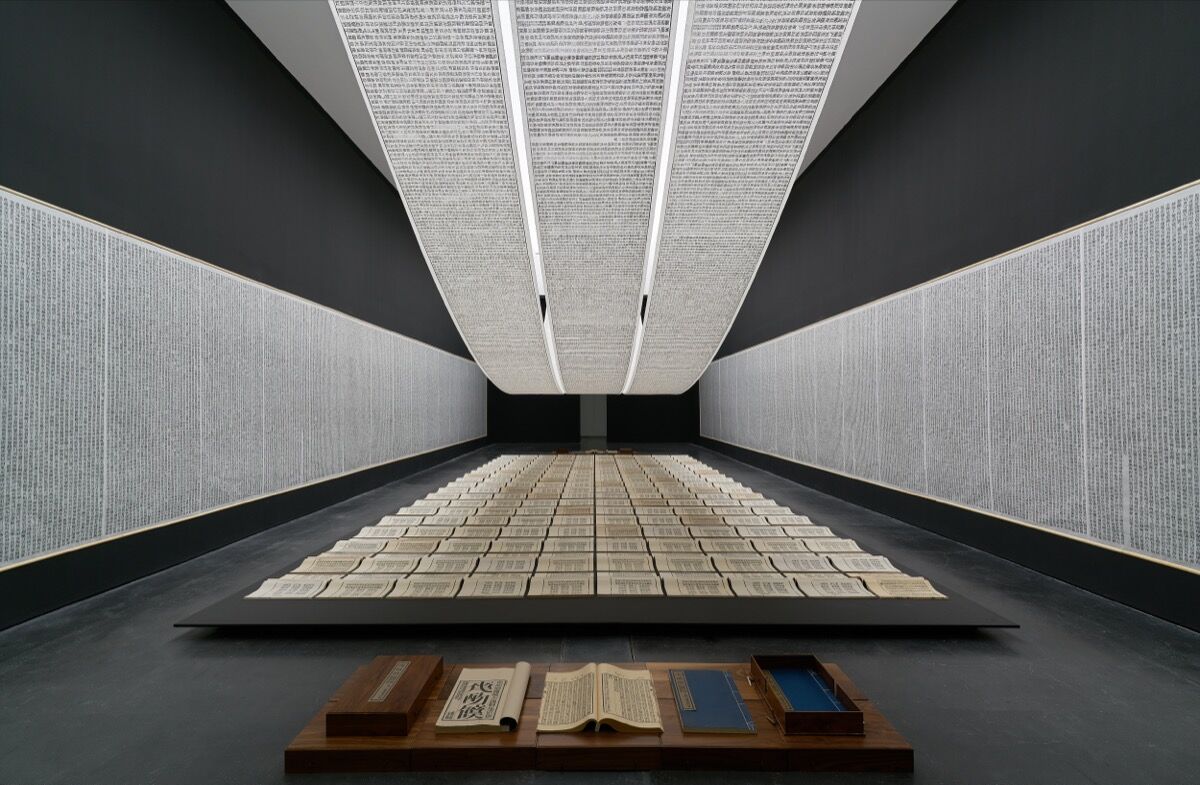
OBSERVATION PROMPT: Look at Xu Bing’s artwork with square word calligraphy. Can you find familiar letters or shapes within the characters? What do you think they mean?
EXPERIMENTATION: Design a secret code using symbols or characters you create. Can you write a message that only you and your friends can understand?
FURTHER RESEARCH: Analyze Xu Bing’s use of language and cultural identity in his artworks. How does his fusion of different writing systems challenge traditional notions of communication? Discuss the impact of his art on your understanding of language and cultural diversity.
PRACTICAL ACTIVITY: Create your own artwork inspired by Xu Bing’s concept of merging languages. Combine elements from different writing systems to create a unique script that represents your identity or a message you want to convey.
Gu Wenda
Gu Wenda is a contemporary Chinese artist known for his innovative approach to art, particularly his exploration of pseudo-languages and their connection to Chinese calligraphy. His work delves into the intersection of language, culture, and identity, often challenging traditional notions of communication.
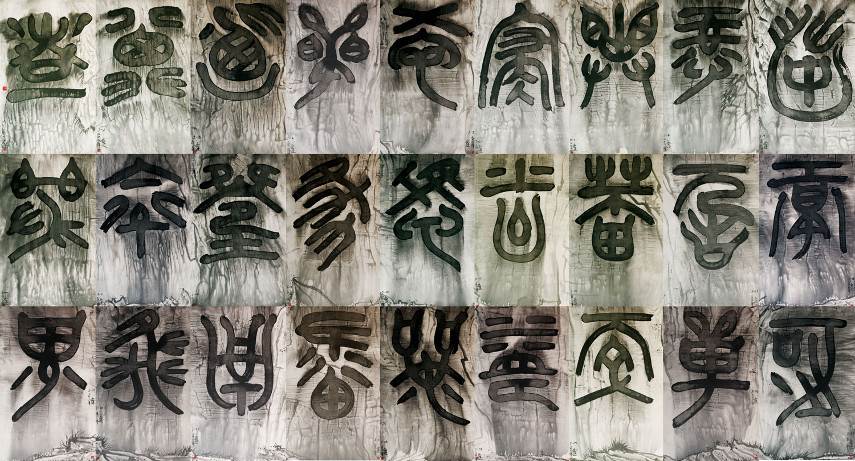
One of Gu Wenda’s notable works is the “Temple of Heaven” installation, where he created a massive scroll of artificial hair that hangs from the ceiling, resembling a cascading waterfall. The hair is dyed with ink made from plant and mineral sources, reminiscent of traditional Chinese ink used in calligraphy. Through this installation, Gu Wenda evokes the aesthetic essence of Chinese calligraphy, transforming hair into a unique artistic medium that blurs the boundaries between writing and visual art.
In his series “Drama of Two Cultures,” Gu Wenda further explores the concept of language and cultural exchange. He combines Chinese characters and English letters in intricate patterns, creating a visual language that transcends linguistic barriers. By interweaving different scripts and symbols, Gu Wenda challenges the dominance of any single language and emphasizes the universality of communication.
Another significant work by Gu Wenda is the “Forest of Stone” project. Inspired by ancient Chinese stone inscriptions, he created a series of carved stone tablets with characters that are neither Chinese nor any other recognizable language. The tablets are covered with random shapes and lines, mimicking the appearance of ancient inscriptions while subverting their meaning. Through this work, Gu Wenda prompts viewers to question the nature of language and the value of deciphering meaning in written texts.

EXPERIMENTATION: Explore making marks and patterns using unconventional materials such as feathers, leaves, and other found materials. How does it feel different from using a regular pen or pencil?
DISCUSSION PROMPT: Reflect on the role of language in shaping identity. Write a personal essay or create an artwork that explores how your native language, the languages you encounter, and the cultures they represent contribute to your sense of self.
PRACTICAL ACTIVITY: Experiment with different tools, surfaces, and unconventional materials to create expressive and abstract calligraphy pieces. How can you push the boundaries of traditional calligraphy to make it your own?
Wang Tiande
Wang Tiande’s art reflects a deep understanding of traditional calligraphy while pushing its boundaries and exploring new forms of expression.
Wang Tiande’s works often combine calligraphic brushstrokes with abstract compositions and contemporary materials. He experiments with different techniques, such as splattering, dripping, and layering ink, to create dynamic and expressive textures reminiscent of calligraphic movements. His use of space, rhythm, and balance in his compositions reflects the principles of Chinese calligraphy.
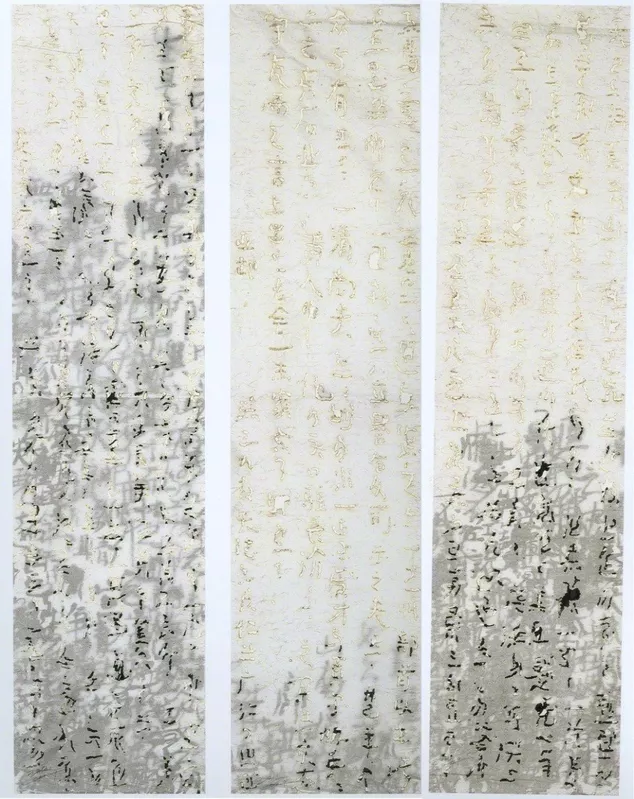
One significant aspect of Wang Tiande’s art is his incorporation of calligraphic texts into his works. He explores the relationship between text and image, using classical Chinese poems or philosophical writings as a starting point. Wang Tiande’s approach to calligraphy is not limited to replicating traditional characters but focuses on the expressive qualities of brushwork and the aesthetic experience it evokes.
Wang Tiande’s art reflects a deep appreciation for the history and cultural significance of Chinese calligraphy; his works pay homage to ancient masters and traditions, while also engaging in a contemporary dialogue. By reinterpreting and reinventing calligraphy through his artistic practice, Wang Tiande brings a fresh perspective to the art form, bridging the gap between tradition and innovation.
PRACTICAL ACTIVITY: Create textured surfaces by dipping fingers or brushes into paint and then pressing them onto paper. Observe the unique patterns and textures that emerge, similar to the textures in Wang Tiande’s artworks.
PRACTICAL ACTIVITY: Encourage students to use lines to tell a story or draw something they like. Ask them to explain their artwork and the meaning behind the lines they used.
PRACTICAL ACTIVITY: Explore different ways of using ink and brushes, inspired by Wang Tiande’s techniques. Try splattering ink onto paper, creating washes with different dilutions, and experimenting with various brush sizes and shapes.
PRACTICAL ACTIVITY: Read a classical Chinese poem together and discuss its imagery and emotions. Ask students to create an artwork that visually represents the essence of the poem, using calligraphy-inspired brushstrokes and abstract forms.
Wang Dongling
Wang Dongling is a renowned contemporary Chinese artist known for his dynamic and expressive style of calligraphy, pushing the boundaries of traditional calligraphy and exploring new possibilities for self-expression. Wang Dongling’s work is deeply rooted in the rich history and traditions of Chinese calligraphy, while also incorporating innovative techniques and personal interpretations.
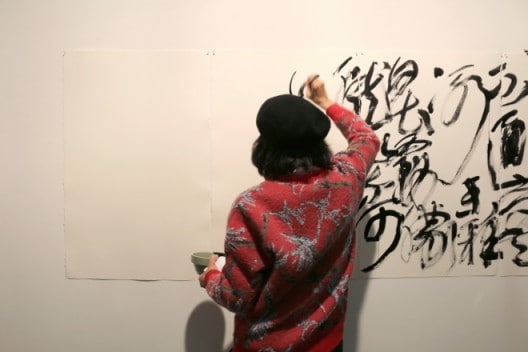
Wang Dongling’s calligraphy is characterized by its large-scale format, bold brushstrokes, and energetic compositions. He often uses his whole body to create sweeping and gestural movements, infusing his work with a sense of vitality and rhythm. His calligraphic strokes become abstract forms that evoke emotions and convey the essence of the written characters.
One distinctive aspect of Wang Dongling’s art is his experimentation with the visual arrangement of calligraphy. He breaks away from the conventional left-to-right or top-to-bottom orientations and explores unconventional spatial compositions. This creates a sense of movement and tension within his works, challenging the traditional notions of calligraphy as static and contained.
In addition to his exploration of form and composition, Wang Dongling also explores the philosophical and spiritual dimensions of calligraphy. He incorporates elements of Zen Buddhism and Daoism into his art, emphasizing the connection between mind, body, and brush. His calligraphic works become a meditative practice, a way to cultivate inner stillness and channel energy through the brush onto the paper.
Wang Dongling’s art reflects a deep understanding and appreciation of the historical lineage of Chinese calligraphy while pushing the boundaries of its traditional forms. His innovative approach and experimental spirit have made a significant impact on the contemporary art scene, both in China and internationally. Through his work, he continues to redefine the possibilities of calligraphy as a dynamic and evolving art form.

PRACTICAL ACTIVITY: Let’s play with movement! Use your whole body to make large brush strokes on a big sheet of paper, just like Wang Dongling. How does it feel to express yourself through your body and brush?
DISCUSSION PROMPT: Compare and contrast traditional calligraphy with Wang Dongling’s art. How is his style different from traditional calligraphy? How does his work challenge the traditional concepts of calligraphy as static and contained?
DISCUSSION PROMPT: Analyze the expressive qualities of Wang Dongling’s calligraphy. Choose one of his works and describe the emotions or moods evoked by his brushwork. How does he use movement, rhythm, and space to convey meaning?
FURTHER RESEARCH: Explore the influence of philosophy in Wang Dongling’s art. Research Zen Buddhism and Daoism and their connection to calligraphy. How does Wang Dongling incorporate these philosophies into his work?
Hands-on Activities and Experimentation Ideas
Here is a list of practical activities suitable for different age group to further explore and experiment with Chinese calligraphy.
Primary School:
- Sensory Strokes: Create a sensory experience by filling trays with sand, salt, or rice. Let the children use their fingers or brushes to trace Chinese calligraphy strokes in the material, feeling the texture and movement as they create.
- Body Calligraphy: Explore the concept of calligraphy using the body as the brush. Encourage students to use body movements to create calligraphy strokes in the air or on a large canvas. This unconventional approach adds a dynamic and expressive element to the practice, blurring the boundaries between traditional calligraphy and performance art.
- Water Calligraphy: Practice calligraphy outdoors using water and large brushes on a sidewalk or pavement. The water strokes will evaporate, allowing for endless exploration without any permanent marks. Curiously, outdoor calligraphy is a very popular passtime in China, where is common to encounter elders and children practicing their craft using oversized brushes and water buckets in parks and on sidewalks.
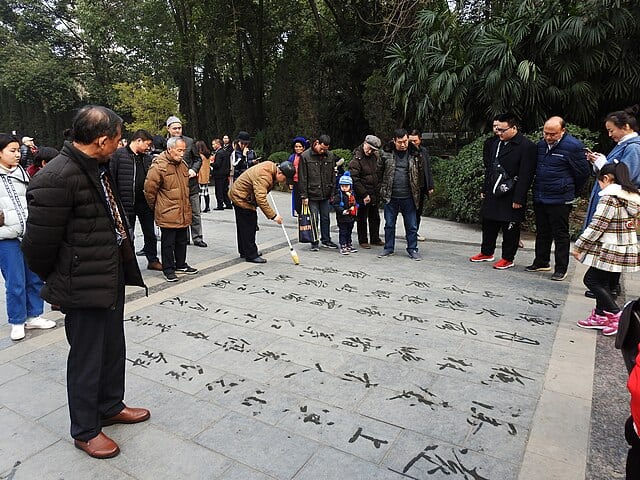
Middle and High School:
- Organize a calligraphy relay race where students take turns running to a designated area, picking up a brush, and making a single stroke before passing it on to the next person. How does the energy and speed impact the strokes?
- Set up a large easel or a whiteboard and encourage children to use oversized brushes or markers to create bold and expressive strokes. How does it feel to use bigger tools for drawing?

Further reading:
- The Art of Chinese Calligraphy: The essential stroke-by-stroke guide to making over 300 beautiful characters Hardcover – Illustrated, February 15, 2016 by Yat-Ming Cathy Ho (Author)
- My First Book of Chinese Calligraphy Spiral-bound – November 10, 2010 by Guillaume Olive (Author), Zihong He (Author)
- Chinese Calligraphy: An Introduction to Its Aesthetic and Technique Paperback – January 1, 1974 by Chiang Yee (Author)
- Chinese Calligraphy (The Culture & Civilization of China) Hardcover – September 23, 2008 by Zhongshi Ouyang (Author), Wen C. Fong (Author)
- Chinese Calligraphy (Introductions to Chinese Culture) 3rd Edition by Chen Tingyou (Author)
- Authentic Replicas: Buddhist Art in Medieval China Hardcover – October 31, 2018 by Professor Hsueh-man Shen (Author)
- How to Read Chinese Paintings (The Metropolitan Museum of Art – How to Read) Paperback – August 1, 2008 by Maxwell K. Hearn (Author)
- Chinese Art: A Guide to Motifs and Visual Imagery Paperback – Illustrated, September 10, 2012 by Patricia Bjaaland Welch (Author)
- Longing for Nature: Reading Landscapes in Chinese Art Hardcover – July 14, 2020 by Kim Karlsson (Editor), Alexandra von Przychowski (Editor), Alfreda Murck (Contributor), Ching-Ling Wang(Contributor)
- The Art of Contemporary China (World of Art) Paperback – April 13, 2021 by Jiang Jiehong (Author)
- Total Modernity and the Avant-Garde in Twentieth-Century Chinese Art (The MIT Press) Hardcover – April 29, 2011 by Minglu Gao (Author)
- Chinese Brushwork in Calligraphy and Painting: Its History, Aesthetics, and Techniques (Dover Fine Art, History of Art) by Kwo Da-Wei (Author)

